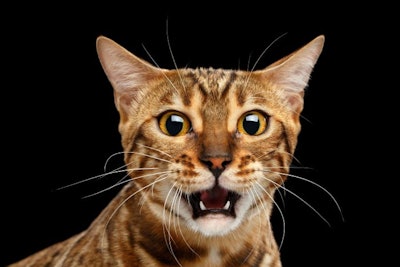
Cat food container size and shape aren’t the solution to thiamine loss during processing, pet food researchers concluded. Although initial experimental results suggested smaller containers might retain more of the essential vitamin, further analysis disproved the correlation. Instead, time and temperature seemed to be the main factors influencing thiamine loss in cat food.
“Cats have a very high requirement for thiamine,” said study co-author Greg Aldrich, Kansas State University professor and Petfood Industry columnist. “So, anything that decreases the quantity below this should be addressed. There are not many options for this at present. The contain type and size don't appear to be that answer. So, other considerations or innovations are needed.”
Thiamine loss during cat food processing
Although thiamine, or vitamin B1, deficiency can be deadly in cats, no one has found a solution to the problem of thiamine loss during high temperature processing.
Aldrich’s team of scientists tried to solve that problem. They conducted research on cat food packaged in three types of containers (cans, pouches or trays) of small or medium size. A total of 64 containers were tested in each of two repetitions of the experiment. The containers were heated under 21 pounds per square inch of pressure until they reached 121 degrees Celsius (250 degrees Fahrenheit) for eight minutes.
At first, the smaller containers seemed to retain more thiamine, niacin and folic acid, while the medium containers retained more pantothenic acid, according to the abstract published in the Journal of Animal Science.
“As we ran further analysis the differences in amount retained were overshadowed when we computed the percent retained from initial,” said Aldrich. “In other words, the decline in thiamine due to processing seems to be consistent from container type and size to the next. It all depends on the time and temperature.”
“We still need to find an answer to the thiamine reduction. Once we have a method to reduce the losses, then there may be an opportunity to adjust over-formulation.”
Health risks of thiamine deficiency
Cats fed diets low in thiamine for several weeks may be at risk for developing a thiamine deficiency, according to the United States Food and Drug Administration. Symptoms of deficiency displayed by an affected cat can be gastrointestinal or neurological in nature.
Early signs of thiamine deficiency may include decreased appetite, salivation, vomiting and weight loss. In advanced cases, neurological signs can develop, which include ventroflexion (bending towards the floor) of the neck, wobbly walking, circling, falling, and seizures.
Recent thiamine-related cat food recalls
In January, the J.M. Smucker Company expanded their voluntarily of certain lots of 9Lives, EverPet and Special Kitty canned cat food due to possible low levels of thiamine (vitamin B1). The affected product was distributed to a limited number of retail customers from December 20 through January 3, 2017.
In May, every can of Best Feline Friend cat food was pulled from pet food retailers in Australia. The removal of Best Feline Friend cat food followed hundreds of reports of cats allegedly becoming ill or even dying after eating the wet pet food.
At the time, heavy metal poisoning was suspected, according to a Weruva statement. However, lab testing found only normal, trace amounts of heavy metals like mercury and cadmium. The test did reveal that the cat food may have contained insufficient amounts of thiamine, a B vitamin essential for cat survival. The symptoms of heavy metal poisoning may mimic those of thiamine deficiency.


















